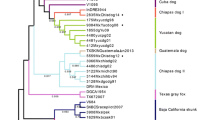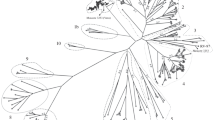Abstract
The Nishigahara strain of rabies virus, a current seed strain used for animal vaccine production in Japan, is believed to derive from the original Pasteur strain obtained from Paris in or before 1915. In Japan, the virus was serially passaged through several kinds of animals and cell cultures. Reactions with anti-nucleocapsid protein monoclonal antibodies (MAb-N) indicated the Nishigahara strain had maintained the antigenic profile of the Pasteur virus. Reactions with monoclonal antibodies to the glycoprotein (MAb-G) revealed differences between the Nishigahara strain and the Pasteur strain; however, the Nishigahara strain maintained a closer resemblance to the Pasteur virus than to other Pasteur-related viruses or to rabies strains unrelated to the Pasteur strain. Comparative amino acid sequence analysis of cloned cDNA encoding the G gene confirmed the antigenic differences among these strains and the resemblance of the Nishigahara strain to the original Pasteur strain. Comparative nucleotide sequence analysis of the noncoding pseudogene region (Tordo et al., Proc Natl Acad Sci USA83, 3914–3918, 1986) revealed different relationships. Unlike the Pasteur strain, which encodes a transcription-terminating signal at the end of the G gene (marking the beginning of the pseudogene), a long G-L intergenic sequence in the Nishigahara strain was connected to the 3′ end of the cDNA, and the transcription-terminating signal was present only at the end of, but not before, the pseudogene. These results are not inconsistent with the documented origin of the Nishigahara strain, but the genome structure around the pseudogene region suggests divergence from the Pasteur strain and a closer resemblance to other strains of rabies virus.
Similar content being viewed by others
References
Tanaka G.,The Rabies (in Japanese). Tohodo-Shoten Publishing House, Tokyo, 1917, pp. 26–39.
Hiraiwa Y.,The Wolf: Its Ecology and History in Japan (in Japanese). Dobutsu-Bungaku-Kai (The Japanese Society for Animal Literature), Tokyo, 1981, pp. 108–117.
Noro G.,Treatments of Bites by Rabid Dog (in Japanese). Tohto-Shoshi Publishing House, Edo (Tokyo), 1736, p. 1.
Shimada K. in Nagano Y. and Davenport F.M. (eds.)Rabies. University of Tokyo Press, Tokyo, 1971, pp. 11–28.
Kondo A. Infect Inflamm Immun10 1–9, 1980 (in Japanese).
Takamatsu Y., Oshima Y., and Takehara K., NIBS Bull Biol ResIV 22–68, 1959 (in Japanese).
Ishikawa Y., Samejima T., Nunoya T., Motohashi T., and Nomura Y., J Jpn Vet Met Assoc42 637–643, 1989.
Smith J.S., Orciari L.A., Yager P.A., Seidel H.D., and Warner C.K., J Infect Dis166 296–307, 1992.
Tordo N., Poch O., Ermine A., Keith G., and Rougeon F., Proc Natl Acad Sci USA83 3914–3918, 1986.
Smith J.S., Adv Virus Res36 215–253, 1989.
Schneider L.G., Barnard B.J.H., and Schneider H.P. in Kuwert E., Merieux C., Koprowski H., Bogel K. (eds.)Rabies in the Tropics. Springer-Verlag, Berlin, 1985, pp. 47–59.
Wiktor T.J., Flamand A., and Koprowski H., J Virol Methods1 33–46, 1980.
Lafon M., Ideler J., and Wunner W.H., Dev Biol Stand57 219–225, 1984.
Gubler U., Hoffman B.J., Gene25 263–269, 1983.
Morimoto K., Ohkubo A., and Kawai A., Virology173 465–477, 1989.
Messing J. and Vieira J., Gene19 269–276, 1982.
Sanger F. and Coulson A.R., FEBS Lett87 107–110, 1978.
Sacramento D., Badrane H., Bourhy H., and Tordo N., J Gen Virol73 1149–1158, 1992.
Anilionis A., Wunner W.H., and Curtis P.J., Nature294 275–278, 1981.
Conzelman K.K., Cox J.H., Schneider L.G., and Thiel H., Virology175 485–499, 1990.
Benmansour A., Brahimi M., Tuffereau C., Coulson P., Lafay F., and Flamand A., Virology187 33–45, 1992.
Mannen K., Hiramatsu K., Mifune K., and Sakamoto S., Virus Genes5 69–73, 1991.
Ertl H.C.J., Dietzschold B., Gore M., Otvos L., Jr., Larson J.K., Wunner W.H., and Koprowski H., J Virol63 2885–2892, 1989.
Yelverton E., Norton S., Obijeski J.F., and Goeddel D.V., Science219 614–620, 1983.
Morimoto K., Kawai A., and Mifune K., J Gen Virol73 335–345, 1992.
Author information
Authors and Affiliations
Rights and permissions
About this article
Cite this article
Sakamoto, SI., Ide, T., Nakatake, H. et al. Studies on the antigenicity and nucleotide sequence of the rabies virus Nishigahara strain, a current seed strain used for dog vaccine production in Japan. Virus Genes 8, 35–46 (1994). https://doi.org/10.1007/BF01703600
Received:
Accepted:
Issue Date:
DOI: https://doi.org/10.1007/BF01703600




